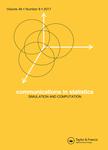版权所有:内蒙古大学图书馆 技术提供:维普资讯• 智图
内蒙古自治区呼和浩特市赛罕区大学西街235号 邮编: 010021

作者机构:McMaster Univ Dept Math & Stat Hamilton ON Canada King Abdulaziz Univ Fac Sci Dept Stat Jeddah Saudi Arabia McMaster Univ Sch Computat Sci & Engn Dept Math & Stat Hamilton ON Canada
出 版 物:《COMMUNICATIONS IN STATISTICS-SIMULATION AND COMPUTATION》 (统计学通讯:模拟与计算)
年 卷 期:2019年第48卷第5期
页 面:1535-1559页
核心收录:
学科分类:0202[经济学-应用经济学] 02[经济学] 020208[经济学-统计学] 07[理学] 0714[理学-统计学(可授理学、经济学学位)]
主 题:Birnbaum-Saunders distribution Cumulative exposure model EM algorithm Monte Carlo EM algorithm Optimization Point estimation Step-stress accelerated life testing Scoring algorithm Type-I censoring
摘 要:The cumulative exposure model (CEM) is a commonly used statistical model utilized to analyze data from a step-stress accelerated life testing which is a special class of accelerated life testing (ALT). In practice, researchers conduct ALT to: (1) determine the effects of extreme levels of stress factors (e.g., temperature) on the life distribution, and (2) to gain information on the parameters of the life distribution more rapidly than under normal operating (or environmental) conditions. In literature, researchers assume that the CEM is from well-known distributions, such as the Weibull family. This study, on the other hand, considers a p-step-stress model with q stress factors from the two-parameter Birnbaum-Saunders distribution when there is a time constraint on the duration of the experiment. In this comparison paper, we consider different frameworks to numerically compute the point estimation for the unknown parameters of the CEM using the maximum likelihood theory. Each framework implements at least one optimization method;therefore, numerical examples and extensive Monte Carlo simulations are considered to compare and numerically examine the performance of the considered estimation frameworks.